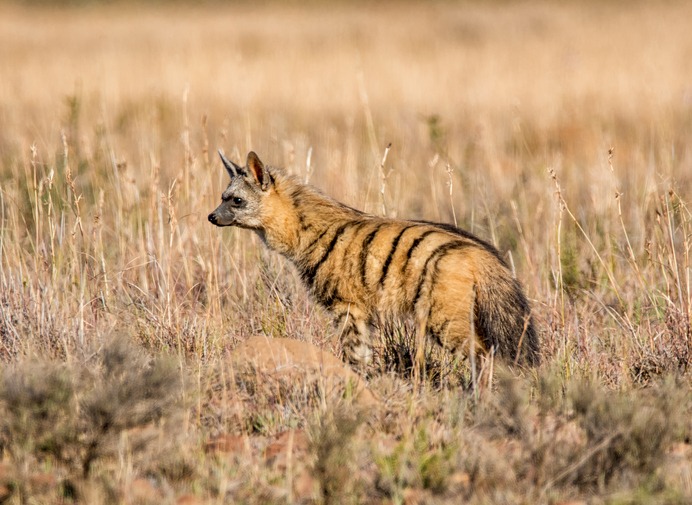SIZE: Shoulder height 50 cm, mass 9 kg.
COLOUR: Sandy to yellow brown body with four to eight dark brown vertical stripes. Black feet and tail tip; a thick dorsal mane from the back of head to base of tail, which is tipped with black.
MOST LIKE: The Brown Hyaena, but the aardwolf's body is smaller. The brown hyaena has a brown body and no vertical stripes.
HABITAT: Open sandy plains and scrubland.
The Aardwolf derives its name from the Afrikaans for 'earth-wolf', as they live in holes in the ground. The aardwolf keeps a low profile and can remain undetected in an area for a long time.
The aardwolf has a similar frame to the hyaena. Its small teeth are weak and set wide apart. Above the aardwolf's anus, it secretes a musky fluid from two glands, and applies a sweet-smelling substance to objects within its home range as a form of communication with other aardwolfs. When an aardwolf gets angry, it lets out a loud roar and raises its long dorsal mane into a crest. Their young are born in burrows which are usually skillfully enlarged by the parents. Males help in rearing the young by guarding the den against jackals, which are probably their greatest natural enemy.
They are very timid animals, and are primarily nocturnal, although they may be active during the late afternoon if termites are available at that time. They often get caught in the beam of car headlights: many aardwolf are killed accidentally by cars. Termites are the aardwolf's main dish and it is guided to them by its sharp hearing and keen nose. do not drink surface water, as they get all of their water requirements from termites. They have been known, however, to drink water during cold spells when termites are not available.
WILDLIFE PARKS AND RESERVES WHERE THIS SPECIES IS FOUND:
